Yoga, often referred to as a “journey to the self,” is a centuries-old practice that has transcended time and culture. It’s not merely a set of physical postures but a holistic approach to wellness that encompasses the mind, body, and spirit. Rooted in ancient India, yoga offers a path to inner peace, improved physical health, and enhanced mental clarity.
It’s a practice that welcomes yoga for beginners with open arms, offering them serenity, strength, and the chance to find their true selves.
In this beginner’s guide, we will unravel the essence of yoga, explore why it’s an ideal choice for newcomers, and provide the tools for a smooth and transformative start on your yogic journey. So, take a deep breath, step onto your mat, and let’s begin this beautiful voyage into the world of yoga for beginners.
Table of Contents
What is yoga?
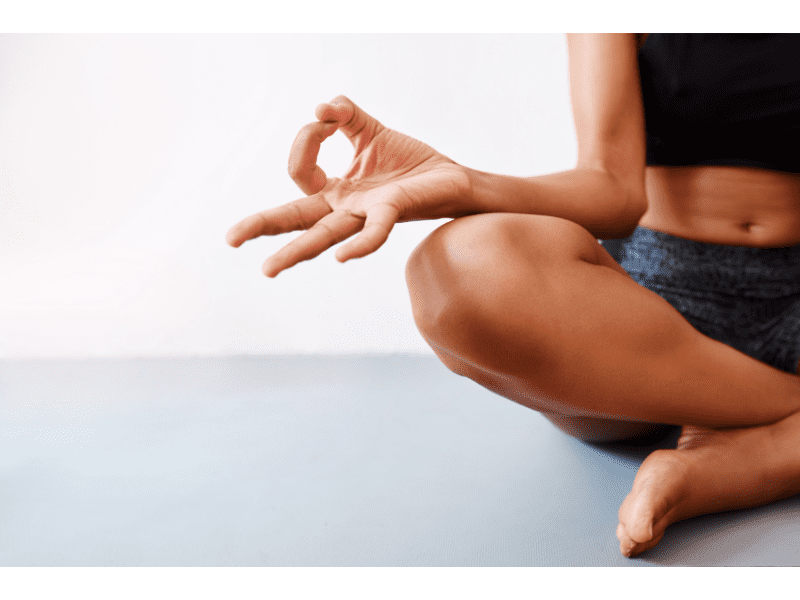
Yoga is an ancient practice that originated in India and has since spread worldwide, transcending cultural boundaries.
At its core, yoga is a holistic system that combines physical postures (asanas), controlled breathing (pranayama), meditation, and ethical principles to promote physical, mental, and spiritual well-being. It is a transformative journey that cultivates mindfulness, flexibility, strength, and inner peace.
Yoga empowers individuals to connect with their inner selves, reduce stress, enhance physical health, and embark on a path of self-discovery and self-improvement. It welcomes practitioners of all levels, offering profound benefits to beginners.
Why should beginners try yoga?
Yoga for beginners offers a gentle yet powerful entry into the world of well-being. It is a practice that harmonizes physical health, mental clarity, and emotional balance, making it an ideal choice for those new to the realm of wellness. Yoga’s accessibility, versatility, and adaptability mean that anyone can begin their journey, regardless of age, fitness level, or previous experience.
Its stress-relieving, strength-building, and flexibility-enhancing benefits make it a compelling option for those seeking physical and mental improvement. Moreover, yoga nurtures self-awareness and inner peace, fostering a positive, sustainable transformation in one’s overall health and outlook on life.
It’s an invitation to beginners to explore their potential and find harmony in their daily lives.
How to approach yoga as a beginner
Approaching Yoga for beginners is a gentle and enriching experience. Start by setting an intention for your practice, focusing on your personal goals and aspirations. Then, gather the necessary equipment, such as a yoga mat and props, to create a comfortable practice space.
Incorporate breathing and mindfulness techniques to enhance your practice’s depth and meaning. Remember that as a beginner, it’s okay to take it slow and listen to your body’s cues. Seek guidance from a qualified instructor or use online resources to ensure you’re practicing safely and effectively.
Embrace consistency and patience in your journey, knowing that each step brings you closer to the many physical, mental, and emotional benefits of yoga.
Yoga for beginners: Getting started
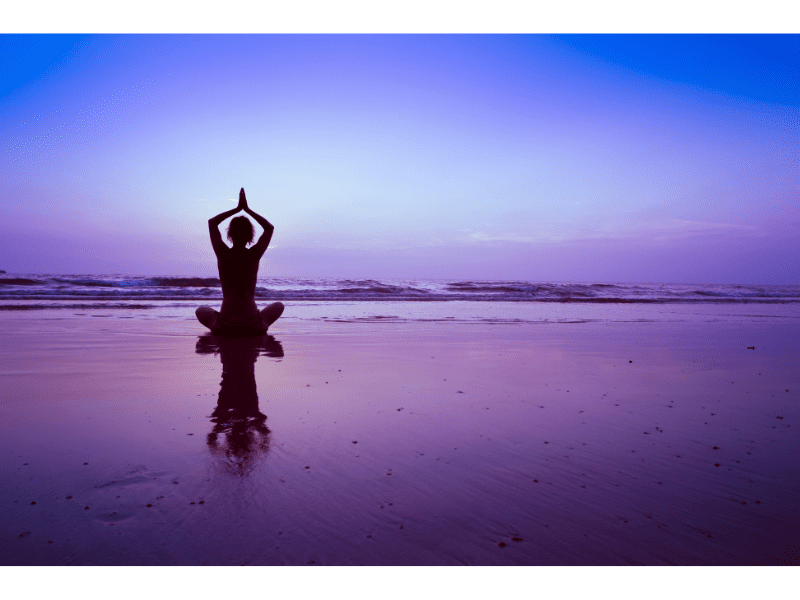
Before you embark on your Yoga for beginners practice, take a moment to set your intention. This intention acts as a guiding star, aligning your yoga journey with your personal goals and aspirations. Whether your aim is to find inner peace, alleviate stress, or enhance your physical well-being, stating your intention creates a profound connection between your practice and your desires.
It’s a reminder of the purpose behind each pose and each breath, adding depth and meaning to your yoga experience. So, take a moment to reflect, set your intention, and let it light the way on your yoga path.
Selecting the right yoga mat and props is more than just a practical choice; it’s a key to your comfort and stability during your practice. A high-quality yoga mat offers the traction and cushioning necessary for a safe and comfortable experience.
Depending on the style of Yoga for beginners you choose, props like blocks, straps, and blankets can enhance your practice and assist you in various poses, ensuring that you practice safely and effectively.
Your mat and props become your trusted companions on your yoga journey, providing support and enabling you to explore your practice with confidence.
Your practice space is your sanctuary, and its ambiance can significantly impact your yoga experience. To craft a comfortable practice space, choose a quiet and clutter-free area in your home. Add elements that inspire serenity, such as soft lighting, plants, or soothing colors.
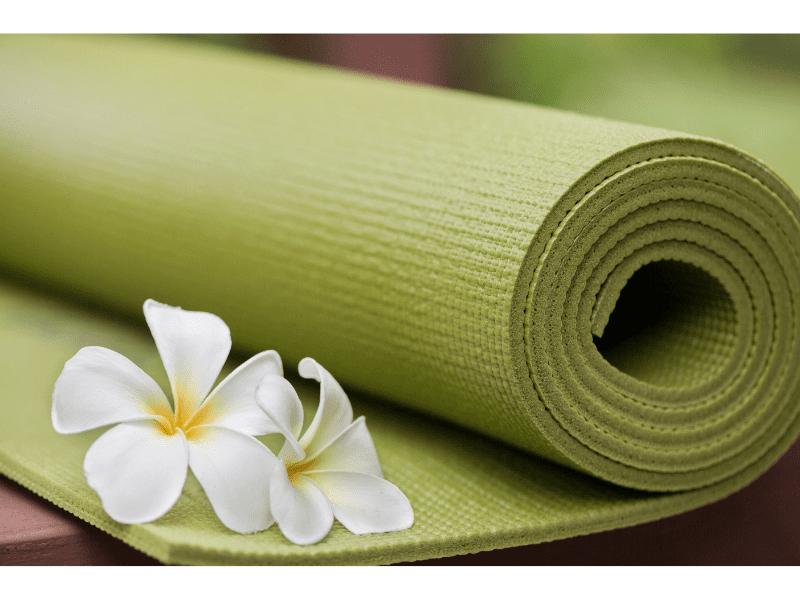
This space is your canvas for self-discovery and growth, so make it inviting and calming. A well-designed practice area sets the stage for an enriching yoga journey where you can fully immerse yourself in your practice, leaving the outside world behind.
Yoga is not just about physical postures; it’s a harmonious union of body and mind. Breathing and mindfulness techniques are the invisible threads that weave this union together. By incorporating conscious breathing into your practice, you synchronize your movements with your breath, fostering a deeper mind-body connection.
Mindfulness techniques guide you to stay present and fully engage with each moment on the mat. These practices are your anchors, grounding you in the present and enhancing the transformative power of yoga.
They bring serenity, clarity, and a sense of oneness to your practice, making every session a voyage of self-discovery and well-being.
Beginner-friendly yoga poses
1. Mountain Pose (Tadasana)
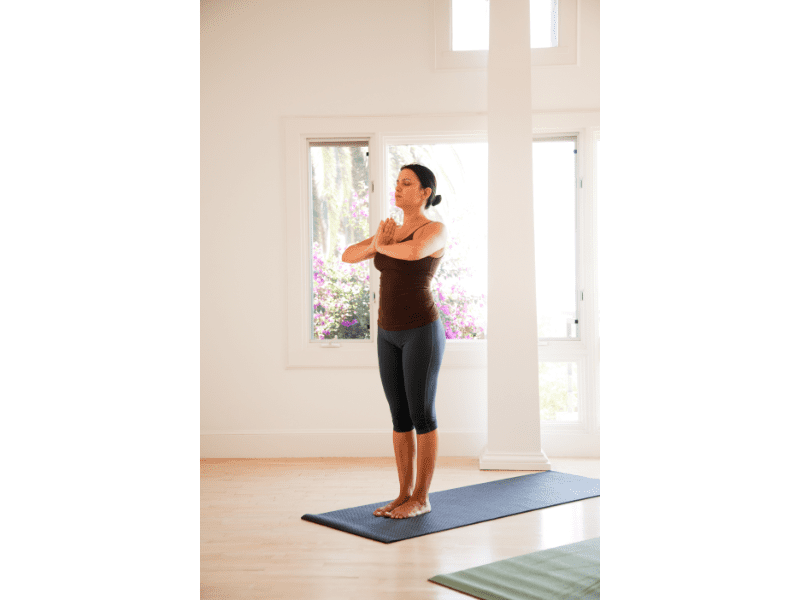
The Mountain Pose is your foundation, both physically and spiritually. In this pose, you stand tall with your feet together, shoulders relaxed, and palms facing forward. It’s an ideal starting point for beginners, helping you build awareness of your body’s alignment and cultivate a sense of grounding and balance.
2. Downward-Facing Dog (Adho Mukha Svanasana)
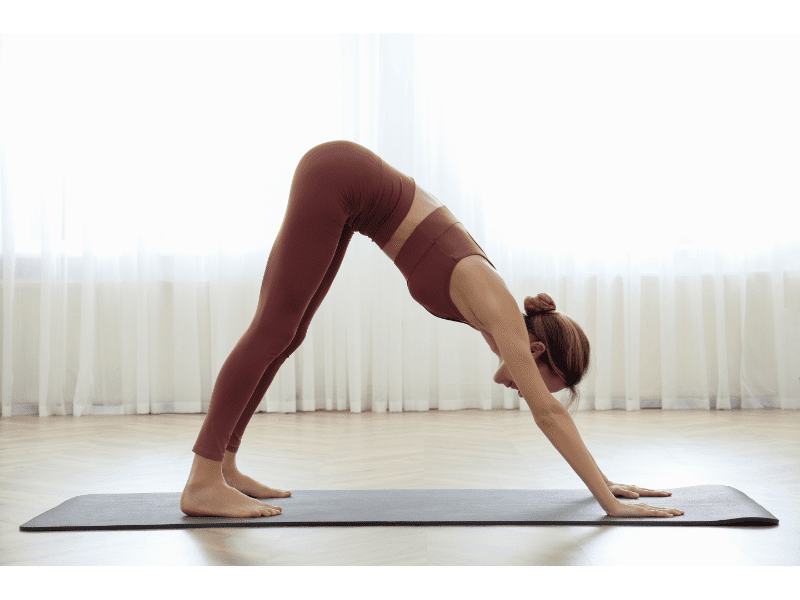
Downward-Facing Dog is a classic yoga pose that provides a full-body stretch. Begin on your hands and knees, then lift your hips toward the ceiling, forming an inverted “V” shape with your body. It’s a great pose to alleviate tension, strengthen your arms and legs, and find tranquility through its gentle inversion.
3. Child’s Pose (Balasana)
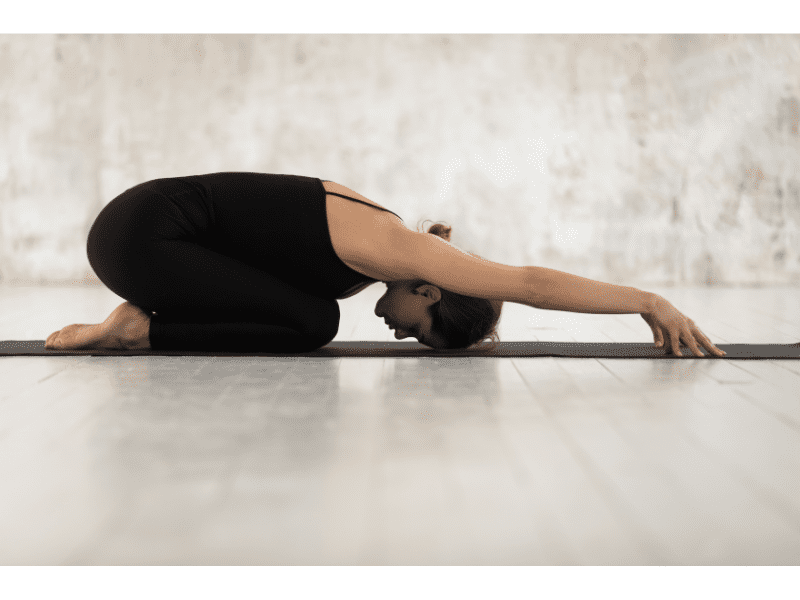
Child’s Pose is your go-to relaxation pose. Kneel on the mat, sitting back on your heels, and extend your arms forward, resting your forehead on the ground. It’s a comforting posture that encourages rest, stress relief, and a sense of safety, making it a perfect option for beginners to return to at any point during their practice.
4. Warrior II (Virabhadrasana II)
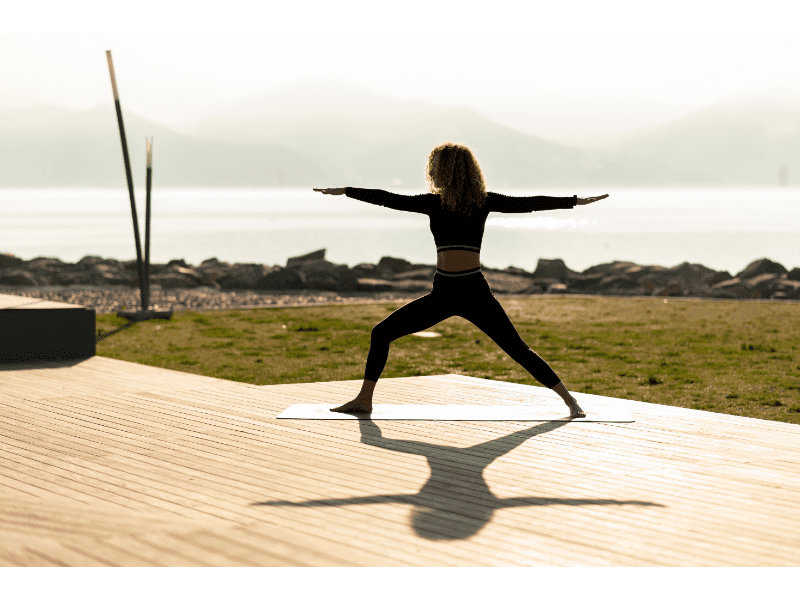
Warrior II is a strong and empowering pose that enhances leg strength and flexibility. You stand with your feet wide apart, one foot pointing forward and the other outward. Stretch your arms out in opposite directions, creating a warrior-like stance. This pose not only strengthens your body but also instills a sense of determination and focus.
5. Tree Pose (Vrksasana)
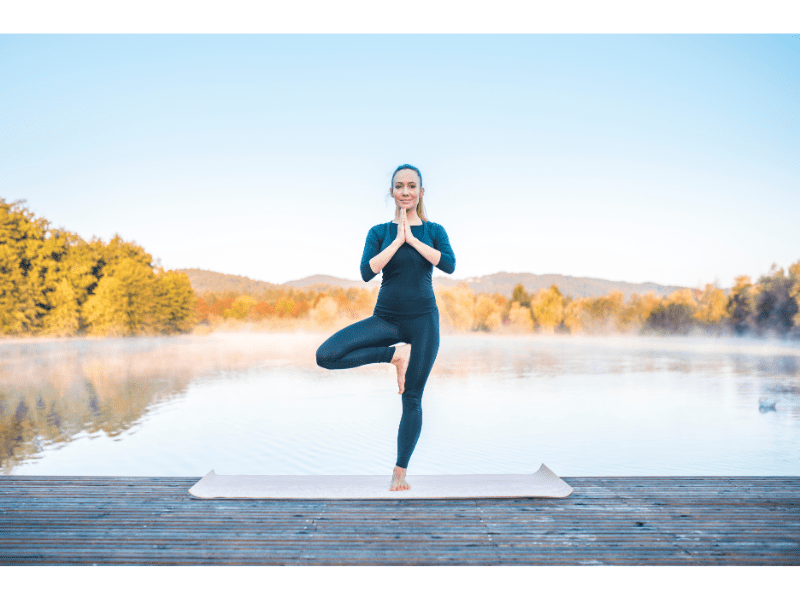
The Tree Pose is a balancing posture that encourages focus and stability. Begin by standing with your feet together, then lift one foot and place it against your inner thigh, calf, or ankle. Balancing in this pose requires concentration, building your mind-body connection, and enhancing your sense of poise.
These beginner-friendly yoga poses are the stepping stones to a more profound yoga practice. They offer a range of physical benefits while nurturing your mental and emotional well-being.
Understanding Yoga Benefits for Beginners
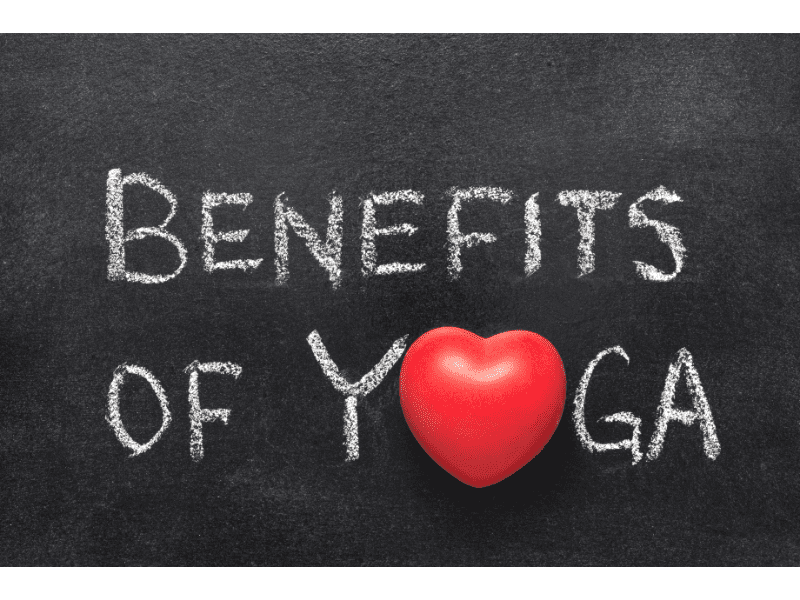
- Stress Relief and Relaxation:
Yoga serves as a sanctuary for stress relief and relaxation. Through intentional breathwork, gentle movements, and mindfulness, beginners can unwind and release accumulated tension. Each pose becomes a moment of tranquility, allowing stress to melt away, leaving practitioners with a calm and centered state of mind.
- Improved Flexibility and Strength:
Yoga’s gentle yet effective postures work wonders for both flexibility and strength. Beginners gradually find themselves moving more fluidly and gaining strength in muscles they may not have actively engaged before. This newfound flexibility not only enhances physical well-being but also fosters a sense of liberation within the body.
- Enhanced Mental Clarity and Focus:
As beginners embrace the mindfulness aspects of yoga, mental clarity and focus naturally follow suit. The practice encourages a present-moment awareness that carries beyond the mat. Breathing consciously and navigating through poses demand concentration, honing the mind’s ability to stay focused and sharp.
- Boosted Self-Confidence and Body Awareness:
Yoga promotes a positive relationship between the body and mind. As beginners progress in their practice, they gain a heightened awareness of their bodies, fostering a sense of self-confidence. Achieving poses, no matter how small the progress, becomes a testament to personal growth and capability, instilling confidence in both the physical and mental realms.
Tips for Beginners to Enhance Their Yoga Practice
- Start Slowly and Listen to Your Body:
Beginners, take heed: the key to a fulfilling yoga journey is to start slowly and attentively. Respect your body’s cues, easing into poses and movements at a comfortable pace. Yoga is a personal journey, and progress is measured not by speed but by mindful progression. Listen to your body’s whispers, and gradually, you’ll find yourself dancing with the poses at your own rhythm.
- Seek Guidance from a Qualified Yoga Instructor:
In the vast landscape of yoga, a knowledgeable guide can make all the difference. Seek the wisdom of a qualified yoga instructor, someone who can offer personalized advice, correct your form, and guide you through the intricacies of the practice. Their expertise ensures that your journey is both safe and transformative, providing a solid foundation for your evolving practice.
- Incorporate Yoga into Your Daily Routine:
Consistency is the heartbeat of progress. Make yoga a daily companion by incorporating it into your routine. Whether it’s a sunrise session, a midday stretch, or an evening wind-down, weaving yoga into your daily life nurtures a continuous connection with your practice. This steady commitment becomes the catalyst for enduring growth and well-being.
- Stay Consistent and Be Patient with Yourself:
Rome wasn’t built in a day, and neither is your yoga practice. Stay consistent, even on days when the poses feel elusive or the mind is restless. Patience is your ally; transformations unfold in their own time. Embrace the process with kindness, celebrate the small victories, and remember that each moment on the mat is a step toward a more harmonious and grounded self.
Common Challenges for Beginners in Yoga
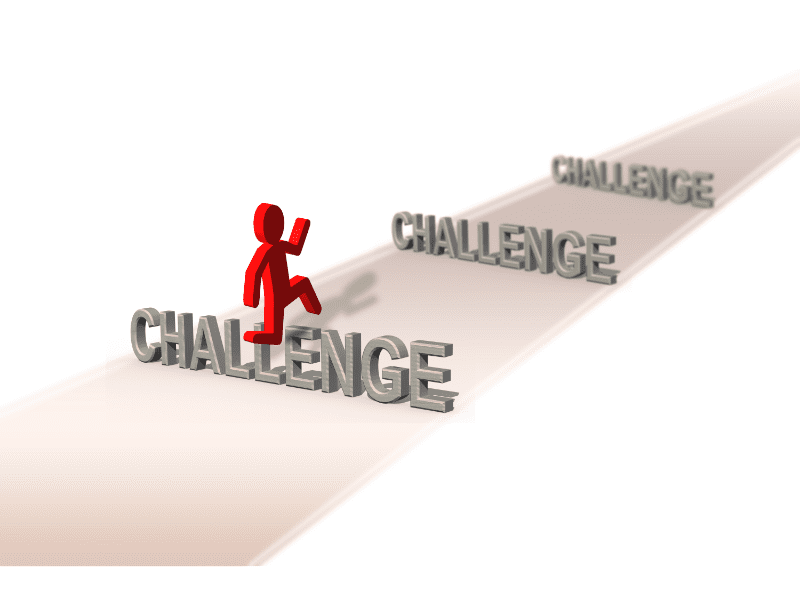
It’s natural for beginners to encounter the challenge of limited flexibility. Yoga is not about contorting into perfect shapes but about the journey towards increased flexibility. Embrace where you are, breathe through the stretches, and witness your body gradually unfold in its unique way.
The bustling mind can be a formidable adversary on the yoga mat. The challenge lies in fostering a tranquil mind amidst the ebb and flow of thoughts. Gently guide your focus back to the present, utilizing breath awareness and mindfulness techniques to quiet the mental chatter. Remember, it’s okay; the practice itself is a journey of cultivating a calm mind.
In a world of Instagram-worthy yoga poses, beginners may find themselves comparing their practice to others. The true essence of yoga lies in personal growth, not in external benchmarks. Banish self-judgment, relish your unique journey, and celebrate the progress you make, no matter how small.
Stepping onto the mat can evoke feelings of vulnerability and self-consciousness, especially for beginners. Whether it’s fear of not being ‘good enough’ or concern about how you look in a pose, recognize these fears as part of the journey. Yoga is a safe space for exploration; let go of judgments and allow yourself to unfold authentically.
Recap of Key Points is yoga for beginners
In this Yoga for beginners guide, we embarked on a journey of self-discovery and holistic well-being. Starting with the foundational poses like Mountain and Downward-Facing Dog, we explored the benefits of stress relief, improved flexibility, enhanced focus, and boosted self-confidence that Yoga for beginners.
Understanding the importance of setting intentions and creating a comfortable practice space, we delved into the significance of incorporating mindful breathing techniques. Tips Yoga for beginners, including starting slowly, seeking guidance, incorporating yoga into daily routines, and practicing patience, were shared to enrich the yoga experience.
Addressing common challenges, such as the initial lack of flexibility, distractions in the mind, comparison, and self-judgment, we emphasized embracing these challenges as integral parts of the transformative journey. Overcoming fears and self-consciousness was encouraged as we recognized the mat as a safe haven for personal growth.
In the heart of it all, we celebrated the uniqueness of each beginner’s path, highlighting that yoga is not a destination but a continuous, beautiful journey. The key is to stay consistent, be patient, and relish the evolving practice that unfolds on the mat. As we conclude this guide, remember that every breath, every stretch, and every moment on the mat is a step towards a more balanced, centered, and harmonious self.
To every beginner stepping onto the yoga mat, take a deep breath and know that this journey is uniquely yours. Embrace the learning curve, relish the small victories, and honor the whispers of your body. Yoga is not about perfection; it’s about self-discovery, growth, and a mindful connection with yourself.

In each pose, find the joy of exploration. Feel the stretch, breathe through challenges, and let the mat be your canvas for expression. Release the need for comparison, and instead, celebrate the beautiful journey you’re embarking upon. Remember, there’s no rush; the magic lies in the process.
You’re not just practicing yoga; you’re cultivating a relationship with your body, mind, and spirit. So, let each inhale inspire, each exhale release, and each moment on the mat be a celebration of your commitment to well-being. Embrace the wisdom of your practice, and as you continue, you’ll find that yoga isn’t just a series of poses; it’s a dance with your authentic self. Welcome to this beautiful journey – you’re exactly where you need to be.
As we conclude this Yoga for beginners, remember that your journey has just begin. Embrace the sense of self-discovery, serenity, and strength that yoga brings into your life. Your mat is a sanctuary, and each practice is a step towards a more balanced and centered you.
For those eager to delve deeper, there are abundant resources waiting to guide you on your yoga journey. Online platforms offer classes for every level, bringing the guidance of experienced instructors to your home. Books, podcasts, and local classes provide additional avenues for exploration. Seek out the wealth of knowledge available and let it inspire your practice.
Remember, the essence of yoga lies not in achieving perfection but in embracing the journey with an open heart. As you step off the mat, carry the peace and mindfulness into your daily life. Whether it’s a gentle stretch in the morning or a calming pose before bed, let yoga be a companion on your path to well-being. Your journey is uniquely yours, and each breath is an opportunity to nurture the harmony within. Namaste.

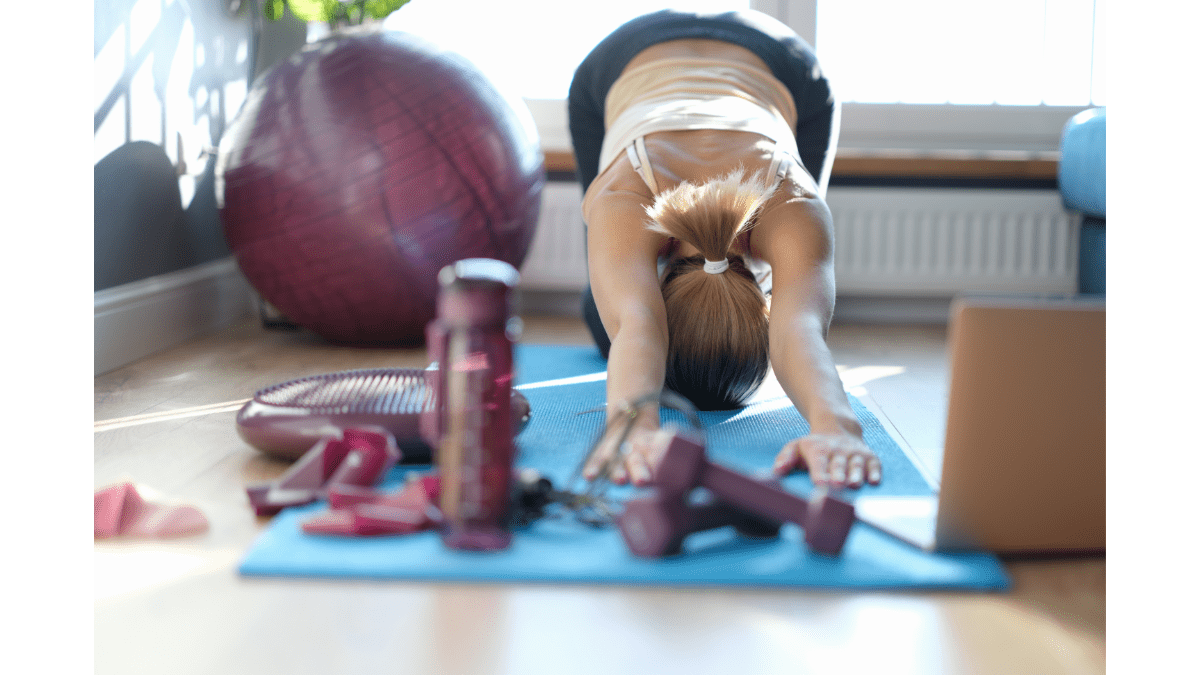
3 thoughts on “Yoga for Beginners: A Step-by-Step Guide to Get Started”